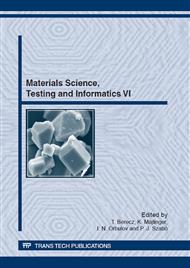[1]
J.R. Davis, Stainless Steels: An ASM Specialty Handbook ASM; New York, (1994).
Google Scholar
[2]
C. Hu, S. Xia, H. Li, T. Liu, B. Zhou, W. Chen, N. Wang, Improving the intergranular corrosion resistance of 304 stainless steel by grain boundary network control. Corr. Sci. 53(5) (2011) 1880-1886.
DOI: 10.1016/j.corsci.2011.02.005
Google Scholar
[3]
Y. Zhou, K.T. Aust, U. Erb, G. Palumbo, Effects of grain boundary structure on carbide precipitation in 304L stainless steel. Scripta Mater. 45(1) (2001) 49-54.
DOI: 10.1016/s1359-6462(01)00990-3
Google Scholar
[4]
M. Kumar, A.J. Schwartz, W.E. King, Microstructural evolution during grain boundary engineering of low to medium stacking fault energy fcc materials. Acta Mater. 50(10) (2002) 2599-2612.
DOI: 10.1016/s1359-6454(02)00090-3
Google Scholar
[5]
L. Tan, K. Sridharan, T.R. Allen, R.K. Nanstad, D.A. McClintock, Microstructure tailoring for property improvements by grain boundary engineering. J. Nucl. Mater. 374(1–2) (2008) 270-280.
DOI: 10.1016/j.jnucmat.2007.08.015
Google Scholar
[6]
M. Shimada, H. Kokawa, Z.J. Wang, Y.S. Sato, I. Karibe, Optimization of grain boundary character distribution for intergranular corrosion resistant 304 stainless steel by twin-induced grain boundary engineering. Acta Mater. 50(9) (2002) 2331-2341.
DOI: 10.1016/s1359-6454(02)00064-2
Google Scholar
[7]
S. Tsurekawa, S. Nakamichi, T. Watanabe, Correlation of grain boundary connectivity with grain boundary character distribution in austenitic stainless steel. Acta Mater. 54(13) (2006) 3617-3626.
DOI: 10.1016/j.actamat.2006.03.048
Google Scholar
[8]
M. Kurban, U. Erb, K.T. Aust, A grain boundary characterization study of boron segregation and carbide precipitation in alloy 304 austenitic stainless steel. Scripta Mater. 54(6) (2006) 1053-1058.
DOI: 10.1016/j.scriptamat.2005.11.055
Google Scholar
[9]
W. Myrjam, Grain boundary engineering by application of mechanical stresses. Scripta Mater. 54(6) (2006) 987-992.
DOI: 10.1016/j.scriptamat.2005.11.042
Google Scholar
[10]
A.J. Schwartz, W.E. King, M. Kumar, Influence of processing method on the network of grain boundaries. Scripta Mater. 54(6) (2006) 963-968.
DOI: 10.1016/j.scriptamat.2005.11.052
Google Scholar
[11]
G. Vander Voort, S. Dillon, E. Manilova, Metallographic Preparation for Electron Backscattered Diffraction. Micros. Microanal. 12 (2006) 1610-1611.
DOI: 10.1017/s1431927606069327
Google Scholar


